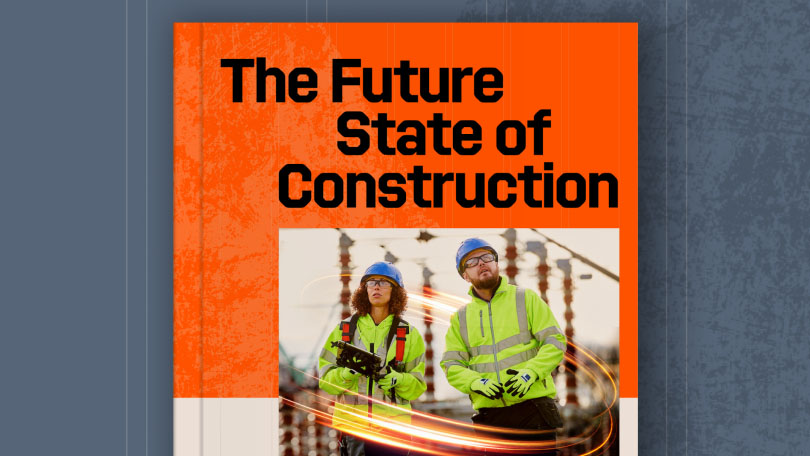— 5 min read
How Unified Data Transforms Construction Projects


Last Updated Sep 15, 2025

Justin Aroyeun
Principal Operations Engineer
Justin is a BIM engineer revolutionising construction with cutting-edge data management and immersive tech. As thought leader on IoT and digital transformation, he is shaping the future of smart, sustainable buildings.

Zoe Mullan
27 articles
Zoe Mullan is an experienced content writer and editor with a background in marketing and communications in the e-learning sector. Zoe holds an MA in English Literature and History from the University of Glasgow and a PGDip in Journalism from the University of Strathclyde and lives in Northern Ireland.
Last Updated Sep 15, 2025

Construction teams generate vast amounts of valuable data that reveals critical details about their work. However, many struggle to harness this information effectively. In today's construction industry, teams face mounting pressure to meet schedules, control budgets, and accelerate delivery. Consequently, unified data practices have become essential for making informed decisions that positively impact timelines, budgets, workforce management, and project outcomes.
Table of contents
What Makes Construction Data “Unified”?
Construction companies increasingly pursue unified data as their ultimate goal. This approach creates a single source of truth by bringing together information from disparate sources. Teams achieve this by integrating and centralising all project-related data into one standardised location, such as a common data environment or construction platform.
Unified project data allows you to take a collaborative approach to tackling the challenges of a project. It's about having input from every area of the project team, and consolidating it into its simplest, most accurate and up-to-date form.

Justin Aroyeun
Principal Operations Engineer
BAE Systems
Moreover, unified construction project data draws from numerous sources across the project ecosystem:
- Supply chain partners
- Subcontractors
- Design teams
- Quality assurance teams
- Health and safety teams
Learn about the future of the built environment - Read Procore's Future State of Construction report
Learn how contractors, subcontractors, and project teams can take advantage of new opportunities to boost efficiency and profitability over the next decade. Download the report to get your roadmap to the future state of construction.

Why Unified Data Drives Success
The primary advantage of unified construction data lies in building trust. When teams implement proper data strategies and processes, they gain confidence that their information remains current, accurate, and reliable. This foundation supports enhanced collaboration and informed decision-making, ultimately improving the bottom line.
I've been on construction sites since I was 18, and over the last 14 years, I've seen countless times why we need unified data to be at arm's reach. Inconsistent or inaccessible data can cost a large-scale project millions, so it's critical that we have quick, easy access to good data.

Justin Aroyeun
Principal Operations Engineer
BAE Systems
Unified data also delivers additional benefits:
- Enhanced collaboration across teams
- Greater visibility into project status
- Reduced errors and rework
- Increased transparency throughout the project
- Accelerated data-driven decision making
Unified construction data allows site teams and project teams to work more in unison, rather than working separately. It inspires a real shift in mindsets to collaboration and a one-team approach.

Justin Aroyeun
Principal Operations Engineer
BAE Systems
How BIM and Unified Data Work Together
When building information modelling (BIM) first emerged on construction sites, many professionals viewed it simply as a transition from 2D designs to 3D models. However, BIM encompasses far more than visual representation – it fundamentally transforms how construction teams approach data and information management.
I like to use the term 'Better Information Management' as another phrase under the BIM acronym, because with BIM you can integrate other types of information that build out a more holistic view of all areas of a project.

Justin Aroyeun
Principal Operations Engineer
BAE Systems
Today, forward-thinking companies expand their BIM approach beyond design data. They now capture and analyse information across procurement, site conditions, workforce numbers, project progress, and more – all within the model. This integration enables teams to predict and simulate progress as projects advance. Consequently, unified project data becomes essential, allowing teams to seamlessly integrate these valuable data streams into BIM models whilst simplifying data access and predictive analytics.
When Data Becomes Dead Weight
Although achieving unified project data requires collecting information from multiple sources, not all data proves valuable. Three key factors help determine whether data deserves a place in your unified system:
Age
How accurate is the information?
Quality
How accurate and complete is the data?
Traceability
Can the source and accuracy be verified?
Some companies maintain data from the 1970s or 1980s, often relating to buildings that have since been demolished or significantly refurbished. In these cases, archiving becomes the sensible choice. Similarly, poor data quality – such as spreadsheets filled with gaps and inaccuracies – threatens overall system reliability and should be removed.
Additionally, traceability plays a crucial role. Teams must be able to trace back to whoever inputted and verified data, enabling them to ask clarifying questions about accuracy. When data lacks this traceability, it creates uncertainty and undermines reliability.
In my opinion, some data is like milk and some is like wine: not all of it ages the same way. Some data might get better over the weeks. Most data, however, will go out of date – especially in a world where our data collection and measurement technology keeps getting more precise.

Justin Aroyeun
Principal Operations Engineer
BAE Systems
Building Team Buy-in
Shifting teams from legacy, siloed data processes to collaborative, unified approaches requires a fundamental mindset change. This transformation applies both to adopting better data collection behaviours and to actually using unified data effectively.
The most effective strategy involves demonstrating direct personal benefits. Workshops that showcase time savings, reduced effort, and less rework help teams understand the value of unified data. However, even after teams grasp these benefits, they need frequent reminders about when and where to use data for quick decision-making support.
When I first started introducing more technology to enhance our data approach, I could see from the analytics that people would open links to data once and then never again. Now, I attach relevant links to data and models to every meeting agenda, and people look at them to prepare for the meeting.

Justin Aroyeun
Principal Operations Engineer
BAE Systems
Over time, this approach builds habits. People begin checking project data before meetings, conversations, and decisions automatically. Strategically placing links to specific project information in agendas and notes further encourages this behaviour.
AI’s Growing Role in Construction Data
Artificial intelligence technology drives a significant shift towards better predictive insights into construction project progress and risks. AI excels at processing large data volumes and using pattern matching to identify potential outcomes, helping construction teams adopt a foresight-driven perspective rather than relying solely on hindsight and lessons learnt.
Importantly, this capability depends entirely on unified project data – AI systems only perform as well as their underlying data foundation.
AI is already helping us make better decisions. As it continues to evolve, we're going to be able to make even better decisions faster and predict clashes and delays long before they occur. I'm excited to see what the next five years have in store for us in terms of AI-driven predictive analytics – we're going to go far beyond what we're using today.

Justin Aroyeun
Principal Operations Engineer
BAE Systems
Construction has the potential to leverage more advanced capabilities than the natural language conversations people currently have with large language models such as ChatGPT. Whilst this represents an excellent starting point, the real value will emerge from advanced analytics and forecasting that proactively predicts outcomes from data, rather than simply coaxing chatbots to answer questions.
Categories:
Written by

Justin Aroyeun
Principal Operations Engineer | BAE Systems
Justin is a BIM engineer revolutionising construction with cutting-edge data management and immersive tech. As thought leader on IoT and digital transformation, he is shaping the future of smart, sustainable buildings.
View profile
Zoe Mullan
27 articles
Zoe Mullan is an experienced content writer and editor with a background in marketing and communications in the e-learning sector. Zoe holds an MA in English Literature and History from the University of Glasgow and a PGDip in Journalism from the University of Strathclyde and lives in Northern Ireland.
View profileExplore more helpful resources

Control the Chaos: Standardising Document Workflows in Construction Projects
Document control and implementation play a central role in managing risk, meeting deadlines, and delivering projects to spec. As builds become more complex and teams increasingly disperse, the volume and...

Cost-Plus Construction Contracts in the UK
A construction cost-plus contract – sometimes called a cost-reimbursable or prime cost contract – reimburses all project costs and adds a fee to cover the contractor’s overhead and profit. UK...

Digital Construction Technology for Whole-Life Value
For decades, the construction industry has kept a narrow focus on capital cost — the one-time, upfront costs of a construction project. While in the short term this seems like...

UK Construction Progress Reports: Tools for Smarter Site Management
Construction progress reports track completed work, on site issues, costs, and safety so UK project teams can demonstrate progress, secure payments, and stay on programme. Accurate progress data is essential...
